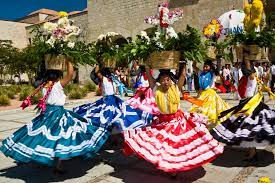May 2022 Meeting: Folk Songs from around the world
- fredericksburgrecorders

- May 1, 2022
- 2 min read
Updated: Aug 25, 2022
GREATER FREDERICKSBURG CHAPTER OF THE ARS
May 1, 2022 Chapter Meeting
Chapter Representative: Dr. Kelly Kazik
Conductor: James Kazik
Website/Blog: https://fredericksburgreco.wixsite.com/mysite
Instagram: @fredrecorder
Rumble channel: https://rumble.com/c/FredericksburgRecorders
See our hybrid meeting here: https://youtu.be/ocLC1vHhIE4
Folk Songs from Around the World
Mexico

Jesus Gonzalez Rubio (d. 1874), Mexican Hat Dance, arr. Kemp (SATB)
Jesus Gonzalez Rubio, composed the tune, Jarabe Tapatio, (the Mexican Hat Dance) in the 19th century. Rubio was professor of music at a private music academy that he founded in Guadalaja. During the 19th century, the tune was used as a courtship dance. Some of the elements of the dance can be traced back to a Spanish zambra and jabba gitano. Today the Jarabe Tapatio is the national dance of Mexico.
Performance: https://www.youtube.com/watch?v=4bFJnpaE5O4
YouTube play along: https://youtu.be/2NGQY1iSmaQ
Rumble play along: https://rumble.com/v12yb18-jesus-gonzalez-rubio-d.-1874-mexican-hat-dance-arr.-kemp-satb.html

Ireland
Traditional, Londonderry Air, arr. (SAT)
The tune Londonderry Air was collected and published by Society for the Preservation and Publication of the Melodies of Ireland in the 1855 collection Ancient Music of Ireland. The origins of the tune are unknown and there is controversy that the version that was heard and collected was mis-transcribed further obscuring the possible origins of the tune. In the 20th century the word to Danny Boy were added to the tune.
Performance: https://www.youtube.com/watch?v=jmp6VcUIFMg
There is no play along for this arrangement.
Bill provided the information for the original music. It can be found here: https://www.amazon.com/God-Bless-Prince-Wales-Twenty-Six/dp/B002DIE2WO
Denmark

Carl Nielsen (1865-1931), Folketone fem Klaverstykker op. 3, arr. Mondrup (SATTB)
Carl Nielsen was a Danish composer, conductor and violinist. He demonstrated musical ability from a young age. He attended the Royal Danish Academy of Music.
Folketone fem Klaverstykke op. 3 is the first piece in a larger suite of 5 pieces. The pieces were individually composed between 1887-9 but 5 pieces were not assembled until 1890-91. Folketone is a stylized children's song and Nielsen adds the work nynnende (humming) to the first bar.
Performance: https://www.youtube.com/watch?v=jXF6B4Zc2LA
YouTube play along: https://youtu.be/hSIXc3bP-EE
Rumble play along: https://rumble.com/v12yal4-carl-nielsen-1865-1931-folketone-fem-klaverstykker-op.-3-arr.-mondrup-sattb.html

New Zealand
Pariare Tomoana (1875-1946), E Pari Ra, arr. Rowe (SATB)
Pariare Tomoana was born in 1875. He was born with a club foot, but excelled in tennis, cricket, hockey, and golf. During World War I he helped raise money for the Maori Soldier’s Fund by organizing song and dance performances throughout New Zealand.
The E Pari Ra was composed in 1918 and was intended to commemorate Maori warriors lost in World War I. According to Folk Song New Zealand, the tune is supposed to be loosely based on the German Waltz, Blue Eyes Waltz. (https://folksong.org.nz/eparira/)
Performance: https://www.youtube.com/watch?v=UbfvTWsIazM
YouTube play along: https://youtu.be/CEcriNr4yF0
Rumble play along: https://rumble.com/v12ya5u-pariare-tomoana-1875-1946-e-pari-ra-arr.-rowe-satb.html
Japan

Traditional, Toka-Ebisu, arr. Kemp (SATB)
Toka-Ebisu is a festival that is held in Japan from January 8-12 with the main focus of the festival taking place on the 10th. The word “Toka” means tenth day and “Ebisu” is the god of good fortune. During the festival, participants make their way to the shrine in Gion to pray to Ebisu.
Read more about this festival here: https://www.insidekyoto.com/toka-ebisu
Performance: https://www.youtube.com/watch?v=DaNBwPK7gWo
YouTube play along: https://youtu.be/pDMT9JdF4UQ
Rumble play along: https://rumble.com/v12ybgi-traditional-toka-ebisu-arr.-kemp-satb.html

USA
Traditional, Cindy, arr. Kemp (SATB)
“Cindy” is an American folk song. It is said to have originated in North Carolina in the early 20th century. As with many folk songs, singers were encouraged to add their own verses. Over time, the original lyrics have been obscured.
Performance: https://www.youtube.com/watch?v=QPlpvd4ujnQ
Youtube play along: https://youtu.be/_hx2JBr1I0Y
Rumble play along: https://rumble.com/v12y9qa-traditional-cindy-arr.-kemp-satb.html






Comments